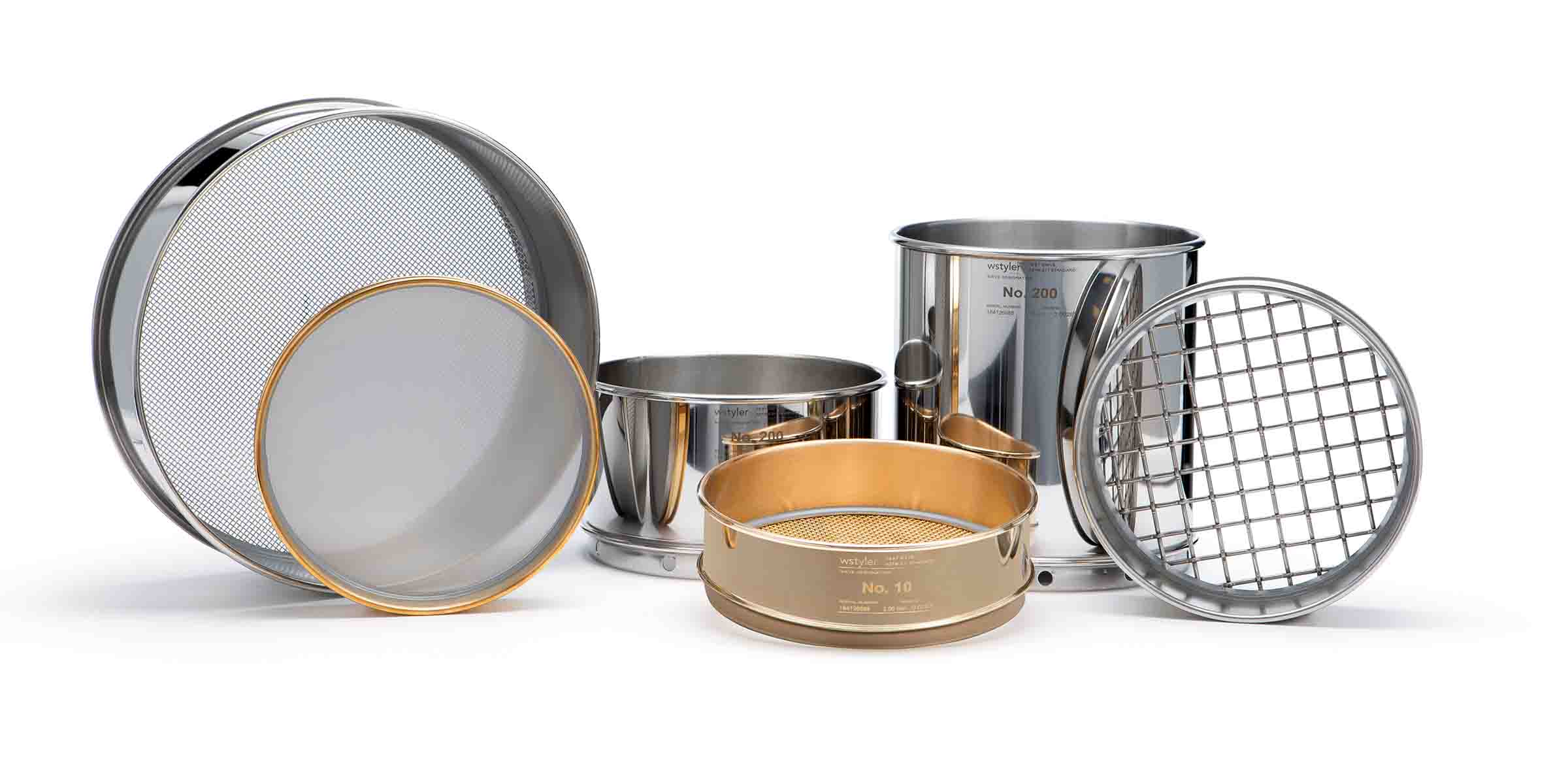What Is a Test Sieve? (Definition, Components, and Types)
Originating from hand-sieving techniques, test sieve analysis is a particle size analysis method that has been practiced for centuries. From the coffee grounds that give us a boost throughout the day to the fertilizers we use to make our yards pop, test sieve analysis is responsible for ensuring the products we use work as intended.
Regardless of how you carry out your test sieve analysis process, the most integral tool in your lab are your test sieves. In fact, your sieve analysis test results are only as accurate as your test sieves.
As the creator of the Tyler Standard Scale Sieve Series, W.S. Tyler has been a leader of innovation in the particle size analysis industry for over 150 years. We strive to share the experiences we've had over the years so you are better equipped to navigate the market and refine the way you test material.
For that reason, the following article was written to shed light on what a test sieve is and its role in the world of particle size analysis. You will learn:
- How test sieves are defined in the world of particle size analysis
- How test sieves work
- The type of test sieve used today
- What components make up a test sieve
- How much test sieves cost
- The test sieve standards that may affect your test sieve analysis process
- What test sieve certification is
What Is a Test Sieve?
A test sieve is a scientific screening instrument, that utilizes wire sieve cloth mounted on a rigid frame to help generate a reliable particle size distribution curve. Sieves with variating mesh openings are typically stacked on top of each other, working to separate the particles of a material sample based on their size.
Now, the parameters surrounding test sieve analysis vary from industry to industry. That said, how you construct your test sieve stack will be reflected in your industry standards.
What Is a Test Sieve Used For?
When someone asks “what is a sieve used for?”, its best to refer to panning for gold as a simplified example.
Imagine someone shaking a pan full of dirt and water looking for pieces of gold. As they shake the pan up and down and from side to side, the small pieces of dirt and water fall through the openings in the screen. The bigger pieces of rocks don’t go through the holes, and they can search through what’s left in the pan for gold.
At a very basic level, this is a test sieve.
Test sieves are used in all kinds of industries to perform particle analysis. Sometimes the particles are super fine, like in the food or pharmaceutical industry. Sometimes the particles can be larger, like in the agricultural and mining industry.
A sieve shaker, such as the W.S. Tyler RO-TAP Sieve Shaker, is a machine that uses some type of agitation to separate the particles down through a stack of sieves. This gives the user a different size sample in each sieve.
Nonetheless, test sieves can be used individually or several can be stacked on top of each other in a sieve shaker.
Types of Test Sieves
There are two predominant types of test sieves used to conduct test sieve analysis. Depending on your sample material, you will either use dry test sieves or wet wash test sieves.
Dry test sieves are used when the particles are free-flowing and can pass through openings with just a shaking or tapping motion.
Wet Wash Test Sieves are used when water needs to be added to the sample to get the particles to pass through the sieve.
Wet wash sieving is often used in the aggregate industry. Clay and silt stick to the outside of the rocks, making them larger than they really are. By adding water to their sieving process, the dirt and silt are cleaned off the outside of the rocks allowing them to be measured properly.
To learn more about wet and dry test sieve analysis, take a moment and review our article: Wet & Dry Sieve Analysis (Alloys, Certification & Sizes).
Components of a Test Sieve
Standard wire cloth sieves typically consist of three components. These components are the wire mesh screen, the frame, and the skirt.
Wire Mesh Screen
The wire mesh screen, often referred to as sieve cloth, is the most technical part of a test sieve. The most commonly used type of mesh is stainless steel woven wire mesh. This comes in opening sizes 4” (100mm) to 635 mesh (20um).
For a more in-depth explanation, refer to our article: How to Pick the Right Woven Wire Mesh (Mesh Count, Wire Diameter, and Micron Rating).
Frame
The frame is the round metal circle that holds the mesh in place. The standard frame sizes in the U.S. are 3-inch, 8-inch, and 12-inch. Internationally, 100mm, 200mm, and 300mm are the standard sizes. Sieve frames can be made of stainless steel or brass.
Skirt
The main function of the skirt is to allow the sieves to be stacked without toppling over.
How Much Does a Test Sieve Cost?
There are hundreds of sieve specifications you can buy. Factors such as the frame height, alloy, and specifications of the sieve cloth all contribute to the overall cost of a test sieve
Typically, A sieve can cost anywhere from $54.02 to $1,380.33.
We wrote an entire article on what a test sieve costs and all the factors and choices that go into that cost. You can read all about it in our article: How Much Does A Test Sieve Cost?
What Are Test Sieve Standards?
One of the most important things to understand when it comes to test sieves are the industry standards. You have to know your industry standards to purchase the correct test sieve. Here's a link to find your industry standards.
Your Industry standards will tell you:
- Your required mesh size
- How many test sieves you need
- How much sample to use
- If you need to use a sieve shaker
- How long you need to run your sample for
- If you need your sieves certified/calibrated
Test Sieve standards relate to the construction of the sieve itself as well as the performance of the sieve.
Our company actually developed the very first test sieve standard over 100 years ago, but there are now two types of standards that are most commonly used: ISO 3310-1 and ASTM E11.
Typically, ISO Standards are international standards. ASTM are the North American standards.
In simpler terms, your standards depend on the material being tested and the industry you are in.
Our product expert wrote an entire article on understanding your industry standards. You can check it out in Your Guide To Particle Analysis Standards.
Test Sieve Certification
Sometimes your industry standards will require you to have your test sieves certified or calibrated. This means your industry requires you to have documented proof that your sieves meet your ISO and ASTM specifications.
Basically, your test sieve is run through a machine that verifies the size of the openings. Your sieves are returned to you with a document that confirms your sieve is compliant to whatever the required specifications are.
Certification is done on a new test sieve before you use it. After your test sieves have been in use for a while, they can become stretched or damaged and need to be sent back in to be re-certified. They are then run through the same test and a “pass” or “fail” is determined. This ensures that they are still performing at their best.
For more information on all things test sieve certification, check out our article What is Test Sieve Certification?
Perforated Plate, or Woven Wire Mesh, That Is the Question
Test sieves are particle size analysis instruments designed to work in conjunction with sieve shakers to separate the particles of a material sample based on their size. With so many ways to customize your test sieve stack, the sieves you should be using should be designated in your industry standards.
When it comes to accuracy, the screen media you choose is critical, as it controls what particles pass and what particles get retained on a test sieve. That's why it's important that you understand how the more widely used and readily available test sieve variants compare.
W.S. Tyler has been a proud leader within the particle size analysis industry for over 150 years and is here to help remove the roadblocks that may be hindering your ability to yield accurate and repeatable results.
To learn how perforated plate sieves and wire mesh sieves compare, read the following article:




